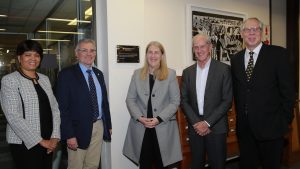 On 20 June 2019, the manuscript collection of the Institute for Democratic Alternatives in South Africa (IDASA) was handed over to Stellenbosch University (SU) by Her Excellency Mrs Helene Budliger Artieda, Ambassador of Switzerland to South Africa. The IDASA collection was acquired by SU with the financial support of the Swiss Confederation. The ceremony took place in the Special Collections division of the SU Library.
On 20 June 2019, the manuscript collection of the Institute for Democratic Alternatives in South Africa (IDASA) was handed over to Stellenbosch University (SU) by Her Excellency Mrs Helene Budliger Artieda, Ambassador of Switzerland to South Africa. The IDASA collection was acquired by SU with the financial support of the Swiss Confederation. The ceremony took place in the Special Collections division of the SU Library.

 “This has been an amazing journey. Switzerland is proud to be associated with this archive and these manuscripts. We have been working on this since late 2015. I’m happy that there will be a lasting memory at Stellenbosch University and that this collection is where it needs to be,” said Artieda during the handover.
“This has been an amazing journey. Switzerland is proud to be associated with this archive and these manuscripts. We have been working on this since late 2015. I’m happy that there will be a lasting memory at Stellenbosch University and that this collection is where it needs to be,” said Artieda during the handover.
The IDASA collection comprises correspondence, interviews, photographs, speeches, pamphlets and reports depicting South Africa’s political history during the 1980s and early 1990s, which Prof Wim de Villiers, Rector and Vice-Chancellor of SU, believes will be of great benefit to researchers and students.




“Stellenbosch University is committed to ‘research for impact’ – that is a core theme in our strategic framework. It is our vision to become Africa’s leading research-intensive university, globally recognised as excellent, inclusive and innovative, where we advance knowledge in service of society and this manuscript collection will help us do exactly that”, said Prof de Villiers.
Drs Frederik van Zyl Slabbert and Alex Boraine formed the Institute for Democratic Alternatives in South Africa (IDASA), later known as the Institute for Democracy in South Africa, in 1986. IDASA’s initial focus from 1987 was on creating an environment for white South Africans to talk to the banned liberation movement in exile, the African National Congress (ANC), prior to its unbanning in 1990 by then President FW de Klerk. After the first democratic election in 1994, IDASA’s focus changed to lead towards the establishment of democratic institutions in the country, political transparency and good governance. The Institute was dissolved in 2013.
Slabbert, who passed away in 2010, was an alumnus of SU and the institution’s 13th Chancellor. The IDASA collection complements other similar collections in the Library, including the Frederik van Zyl Slabbert collection, which was donated to SU in 2014 and opened in 2015.
“We owe Drs Slabbert and Boraine and IDASA a debt of gratitude for helping to shape the environment within which Stellenbosch University could grow more inclusive to the point where we are today, an integrated academic community that celebrates critical thinking, promotes debate and is committed to democracy, human rights and social justice, with an outward, international focus on the future”, said Prof de Villiers.
 Also in attendance at the handover ceremony was Mr Paul Graham, former executive director of IDASA, who gave an overview of the history and significant role the organisation played in shaping South Africa’s democracy. He stated that IDASA was always committed to building capacity for democracy amongst citizens and their governments and is a model that is still worth following today.
Also in attendance at the handover ceremony was Mr Paul Graham, former executive director of IDASA, who gave an overview of the history and significant role the organisation played in shaping South Africa’s democracy. He stated that IDASA was always committed to building capacity for democracy amongst citizens and their governments and is a model that is still worth following today.
“I remain convinced that these tasks are necessary in South Africa as elsewhere and am glad that the Stellenbosch University Library will continue to contribute to that task through the materials made accessible to scholars, and we hope practitioners”, said Graham.
Some of the items in the IDASA collection have been digitised and are available on the Library’s Digital Heritage Repository, SUNDigital Collections – https://digital.lib.sun.ac.za/handle/10019.2/15313. More digitised items will be added in the future.
Adapted from a news article by Rozanne Engel, Corporate Communication, IDASA collection handed over to Stellenbosch University, 20 June 2019.
Photographs by Hennie Rudman and Bronwyn Bruton
